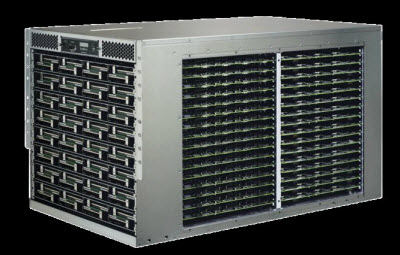
Advanced Micro Devices is acquiring Sea Micro today for $334 million, including $281 million in cash. Sea Micro has been disruptive because it can pack a lot of computing power in a server rack that is about a sixth of the usual size. Its servers use a quarter of the usual electricity and cost a lot less.
[aditude-amp id="flyingcarpet" targeting='{"env":"staging","page_type":"article","post_id":397000,"post_type":"story","post_chan":"none","tags":null,"ai":false,"category":"none","all_categories":"business,","session":"A"}']The servers use Intel’s Atom microprocessors, which are targeted at energy efficient devices such as tablet computers. But AMD’s move could shake things up for Intel, which presumably will lose some of its business.
The advantage of Sunnyvale, Calif.-based SeaMicro’s small and power-efficient computers is that enterprises can now shove a lot more computing power into a given amount of space and use a lot less electrical power, thereby cutting electricity bills dramatically. That matters because electricity costs are the biggest part of the budget for operating data centers.
AI Weekly
The must-read newsletter for AI and Big Data industry written by Khari Johnson, Kyle Wiggers, and Seth Colaner.
Included with VentureBeat Insider and VentureBeat VIP memberships.
Andrew Feldman, chief executive of Sea Micro has said in past interviews that SeaMicro had become the fastest-growing system company in Silicon Valley history. SeaMicro’s customers include France Telecom, Skype, Rogers Wireless, Mozilla, eHarmony, and China Netcom BB. Hundreds of millions of internet users traverse SeaMicro’s hardware daily.
As we’ve described in earlier stories, Intel has been improving its server microprocessors by making them more power efficient. But the microprocessor only accounts for a third of the power consumption in a server. SeaMicro’s innovation lies in how it attacks the remaining two-thirds of the power consumption problem. It does so by combining a lot of the extraneous chips into a single, more-efficient custom chip, Feldman said.
In its earliest system, SeaMicro put 384 Intel Atom dual-core processors (for a total of 64-bit 768 cores) in a 10-rack system, which is just 17.5 inches high. The newer SM10000-64HD was a 20 percent improvement over SeaMicro’s previous server line and a 150 percent improvement on its compute density record, or the amount of computing power in a given space.
That single machine could replace rival systems with a bunch of equipment: 60 traditional servers, four rack switches, four terminal servers, and a load balancing server. It uses a quarter of the power and a sixth of the space. SeaMicro can put an entire server on a motherboard that is 5 inches by 11 inches. Since the hardware is Intel-based, customers don’t have to change their software at all.
SeaMicro was founded in 2007 and is backed with $60 million in funding by Khosla Ventures, Draper Fisher Jurvetson, Crosslink Capital, and a number of strategic investors. It also won grants from the U.S. Departement of Energy ($9.3 million) and the state of California ($250,000). SeaMicro has 80 employees. Most recently, it raised $20 million.
SeaMicro also attacked the power consumption problem with a very clever trick known as virtualization.
[aditude-amp id="medium1" targeting='{"env":"staging","page_type":"article","post_id":397000,"post_type":"story","post_chan":"none","tags":null,"ai":false,"category":"none","all_categories":"business,","session":"A"}']
Today, virtualization is frequently used with servers. It is a layer of software that rests between an application and the servers that it runs on. If an application needs only two servers, the virtualization software finds two available servers to run the application. If the application gets busy and needs 10 servers, the virtualization software finds 10 available servers to do the job. The application is no longer tied to specific servers; the virtualization software frees up the overall system and gets more use out of the available servers.
SeaMicro did the same thing, but it applied the concept of virtualization to the inside of a server. Feldman designed custom chips that could take the tasks that were handled by everything beyond the Intel microprocessor and its chip set. The custom chips virtualize all of those other components so that it finds the resource when it’s needed. It essentially tricks the microprocessor into thinking that the rest of the system is there when it needs it.
SeaMicro virtualized a lot of functions that took up a lot of space inside each server in a rack. It also did the same with functions such as storage, networking, server management, and load balancing. Full told, SeaMicro eliminates 90 percent of the components from a system board. SeaMicro calls this CPU/IO virtualization. With it, SeaMicro shrinks the size of the system board from a pizza box to the size of a credit card.
By boiling down the rest of the system into a couple of chips, SeaMicro can get rid of a lot of the components in a system, thereby getting rid of space, cost, and power consumption.
[aditude-amp id="medium2" targeting='{"env":"staging","page_type":"article","post_id":397000,"post_type":"story","post_chan":"none","tags":null,"ai":false,"category":"none","all_categories":"business,","session":"A"}']
VentureBeat's mission is to be a digital town square for technical decision-makers to gain knowledge about transformative enterprise technology and transact. Learn More
